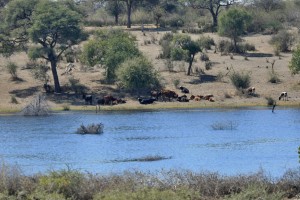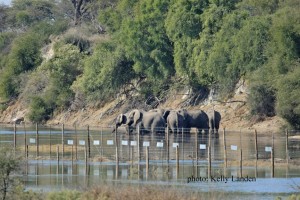Drive along the Boteti
On our continual quest to try and answer questions about the movements and habitat needs of elephants, we have been trying to find elephants in several areas, which they haven’t been seen in a very long time. The EWB team has temporarily moved out of Kasane to follow up on reports of elephant sightings in remote areas. It is our hope to deploy satellite tracking collars on some of these elephants, that occur in areas we know little about their movements. (Why do we collar? click here)

Boteti river is flowing higher than in 30 yrs
This year, the rivers, streams and water flowing into and out of the Okavango delta are higher than ever. (see blog post “Here Comes the Flood”) Surprisingly, even the Selinda Spillway is expected to join the Okavango delta system for the first time in over 50 years! With all this new water, and considering elephants depend on water sources, it isn’t surprising that elephants may be making exceptional and different movements this season. So, Elephants Without Borders has set out to look along the rivers to see where elephants may be found. Yesterday, we drove along the Boteti river, just south of Maun, down to and on the fringes of the Makgadikgadi Pans National Park.
road along the Boteti
It was an exceptionally beautiful drive along white sand roads through cattle farms, small rural villages and modest subsistence farms. (to view more of Botswana life, see our Gallery, click here) I sat up on the Land Rover’s safari seat (outside raised bench seat) bumping along, enjoying the sights of a simple lifestyle while keeping a vigilant eye for elephant clues, spoor (footprints) and dung. I had never seen the Boteti river flowing as it is and it seemed to bring a welcoming ambiance to its surroundings.

rural life
As we passed, the people waved cheerfully and we were greeted by all passersby. The cows, donkeys, goats, and horses all looked fat and without a care. I kept trying to imagine what it was like there during other years, years of harsh dryness and difficulties. This year however, the residence along the river are enjoying its bounty.
Unfortunately, we did not find much evidence of elephants. We found some spoor from a lone bull and another small area, which seemed to had been frequented by elephants some weeks ago. However, we were quite pleased when we did come across a “path”, what seemed to be a major access route for breeding herds to drink from the river. We continued on through many villages, crossing the veterinary fence at Makalamabedi, until we fiinally came to Xhumaga, where the DWNP has a new entrance gate to enter Makgadikgadi Pans National Park. We were surprised as we headed down the hill towards the gate. The river had filled so far that it had cut off the road! No one considered the dry riverbank filling before choosing the gate’s construction site, as it hadn’t flowed this far south in over 17 years !

elephants enjoying new river flow
Standing at the river’s edge, looking over the vet fence, which cuts through the river allowing livestock to drink on one side and wildlife on the other, we spotted our first elephants of the day. There were 8 bulls frolicking and enjoying the relief of the new flowing waters. Too bad, we couldn’t get over there though! After talking to one of the DWNP officials, they advised us to a point off the tar road in which we could get into the park to look at one of their new artificial waterholes, one of 15, that have been recently sunk to help supply the wildlife with water in dry times. It was difficult to find because there were no signs to follow, but listening to Mike’s intuition, we found what we were looking for. As we drove along a dirt road, spotting clear evidence of many elephants, we turned to find the pan. Sure enough, we were greeted by 11 bull elephants vying over the fresh water coming from the pumped trough. We sat and watched them, enjoying all their interactions, for quite some time. As the sun began to set, we decided it was time for us to leave. It was a wonderful way to end the long day of searching… it was like having dessert after a wonderful meal. However, we know that this is only the beginning of this new endeavor.
To learn more about EWB’s work and see how we collar, watch the videos on our web site Video page (click here)
new artificial waterhole in Makgadikgadi
Tags: boteti river, botswana, conservation, elephants, elephants without borders, floods, Makgadikgadi, research







